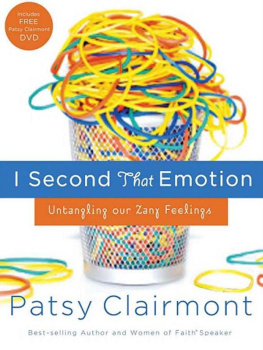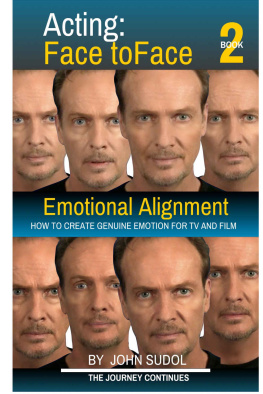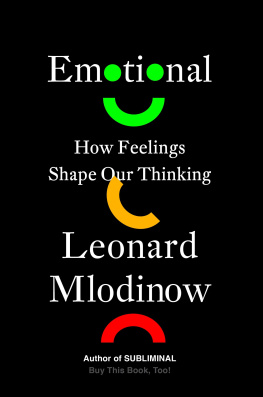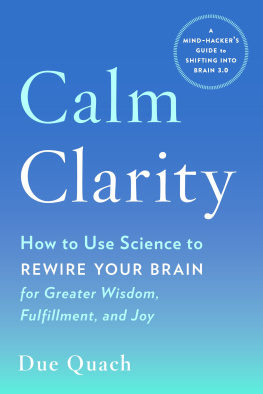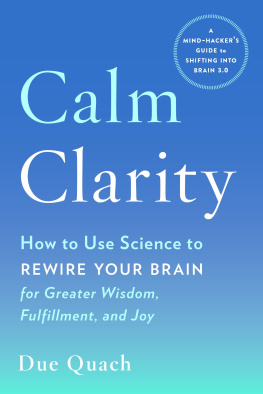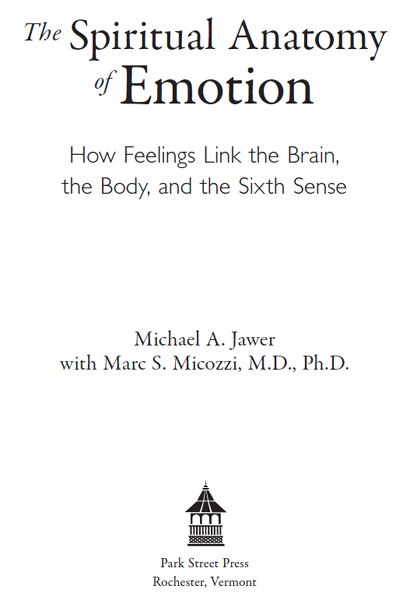
The Spiritual Anatomy
of Emotion

The Spiritual Anatomy of Emotion is brilliant... comprehensive... holistic.
STANLEY KRIPPNER, PH.D., EDITOR OF ADVANCES IN
PARAPSYCHOLOGICAL RESEARCH AND COEDITOR OF
THE VARIETIES OF ANOMALOUS EXPERIENCE
The Spiritual Anatomy of Emotion is a landmark book that presents a picture of consciousness that is far more majestic than anything conceived in conventional neuroscience. Based in solid science, this bold effort will challenge anyone who reads it with an open mind. Highly recommended.
LARRY DOSSEY, M.D., AUTHOR OF
RECOVERING THE SOUL AND REINVENTING MEDICINE
Jawer and Micozzi articulate one of the most profound understandings of consciousness since Descartes. The book brings Antonio Damasios feeling brain into full embodiment. It is a monumental contribution to understanding ourselves as human beings.
ALLAN COMBS, PH.D., AUTHOR OF THE RADIANCE OF BEING
The Spiritual Anatomy of Emotion presents a unique and arresting view of such topics as mind, body, memory, illness, perception, and emotion. The authors show us an altogether novel way of understanding who we are and what were about. Theres more to being human than we ever imagined, and this book is an excellent road-map for anyone who wants to take that journey.
ERIC LESKOWITZ, M.D., DEPARTMENT OF PSYCHIATRY,
HARVARD MEDICAL SCHOOL
Jawer and Micozzi have collected a unique body of data on environmental sensitivity, which has great relevance to human health and psychology. They put together this data with original ideas on emotion very persuasively in The Spiritual Anatomy of Emotion. I highly recommend this well-written and accessible book.
ERNEST HARTMANN, M.D., AUTHOR OF
DREAMS AND NIGHTMARES AND
BOUNDARIES IN THE MIND,
PROFESSOR OF PSYCHIATRY AT TUFTS
UNIVERSITY SCHOOL OF MEDICINE,
AND PAST PRESIDENT OF THE ASSOCIATION
FOR THE STUDY OF DREAMS
I agree completely with the thesis in The Spiritual Anatomy of Emotion from what I have observed in the many case reports we receive from the general public; from a monthly paranormal experience group at our center; and from my experience as a clinical psychologist.
SALLY FEATHER, PH.D., DIRECTOR OF RESEARCH,
RHINE RESEARCH CENTER
Jawer and Micozzi have come up with important findings that could open up a whole new field of research.
CARLOS ALVARADO, PH.D., ASSISTANT PROFESSOR
OF RESEARCH IN PSYCHIATRIC MEDICINE,
UNIVERSITY OF VIRGINIA
Acknowledgments

Since this book has been ten years in the making, its my great good fortune to have many wonderful people to thank.
First are the researchers and writers whose work has not only informed and inspired my own but who have aided me in many and sundry ways. They include: Larry Dossey (whose willingness to write this books Foreword has meant so much and who generously offered to publish a paper of mine in his journal, Explore); Ernest Hartmann (a gentleman and scholar whose boundary concept provides this books underpinning); Stanley Krippner (a man of wide-ranging interests whose enthusiasm first signaled that I might have a thesis worth publishing); the late Lyall Watson (whose intrepid forays into the biology of the unconscious Ive enjoyed over the years and who sent along a message that was particularly welcomed); Joseph Chilton Pearce (whose humane discourses Ive likewise followed and who provided one of this volumes first and most enthusiastic endorsements); Rupert Sheldrake (who took the time to meet with me and whose adventurous spirit of science is an inspiration); Kenneth Ring (whose engaging e-mails offered valuable feedback during the books early going); Michael Thalbourne (whose concept of transliminality parallels my own thinking and whose correspondence over the years has provided continual encouragement); Allan Schore (whose willingness to converse with me is so much appreciated given his own trailblazing efforts in the fields of neuropsychiatry and attachment theory); Elaine Aron (whose focus on highly sensitive people pointed me in a helpful direction early on); James Hillman (who kindly corresponded with me when he didnt know me from Adam); Peter Grossenbacher (who patiently conversed on synesthesia and other issues, suggesting many useful ideas along the way); Colin Ross and Lenore Terr (who contributed valuable perspectives on dissociation and trauma, respectively); Mohammad Yunus (whose willingness to discuss sensitivity with a complete stranger was gracious and thoroughly appreciated); Elio Frattaroli (whose book on psychiatry in an age of medication opened up a cogent frame of reference); and Miriam Greenspan (whose work on the dark emotions offers intriguing food for thought).
Next are the parapsychologists, skeptics, and fellow travelers who have done much to illuminate a fascinating but neglected corner of individual experienceand who have helped me a good deal in my pursuit. They include: Bill Roll (whose suggestion it was that I undertake a sensitivity survey in the first place, and whose willingness to include me in one of his field investigations opened up a remarkable window); Sally Rhine Feather (whose invitation to speak at the Rhine Research Center I was gratified to accept and who can be relied upon for helpful responses to most any question); Lisette Coly (whose foundation provided me with the D. Scott Rogo Award, a grant that I was delighted as well as humbled to receive); James Houran (whose review of my first published paper, invitation to join a field investigation, and general good counsel have all been gratefully received); Chris Roe (whose editorship of the Journal of the Society for Psychical Research allowed me to publish my survey findings in one of the fields flagship journals); Caroline Watt (who sent me several papers and supported one of her graduate students in conducting an onsite investigation using the sensitivity survey); Brandon Massullo (that very student, who creatively adapted my survey and shared his findings); Christine Simmonds-Moore (who familiarized me with her research that draws on a similar theoretical base); Paul Stevens (who corresponded on electromagnetism and its possible relation to feeling); the late Ross Adey (who offered a wise perspective based on his study of bioelectromagnetics); Michael Grosso (whose intriguing speculations into the anomalous never fail to hold interest); Stephen Appel (whose open-minded correspondence on sensitivity I much enjoyed); Rick Leskowitz (whose desire to know more about phantom pain and energy healing is impressive); Cyril Smith (whose dedicated research into electrical sensitivity I have valued); Anne Silk (who generously shared materials relating to the same form of sensitivity); Albert Budden (who presented his intriguing take on a connection between allergies and electrical sensitivity); Dean Radin and Marilyn Schlitz (who passed along relevant information from their vast knowledge base at the Institute of Noetic Sciences); Bruce Greyson (who contributed many helpful comments from his own extensive experience); David Ritchey (who compared notes with me based on his project on anomalous sensitivities); Doug Richards (who shared his paper relevant to boundaries); Charles Tart (whose comment You might be on to something captured the refrain I heard from so many other valued sources); Stephen Braude (whose correspondence never failed to tickle in some way); Berthold Schwarz (a veteran psychical investigator who cheered me with his comments); the late Theo de Graaf (who kindly wrote to me concerning his research into trauma and its parapsychological import); Allan Cooperstein (who shared his work on exceptional forms of healing); Michael Piechowski (who shared his expertise concerning gifted children and over excitabilities); Diane Corcoran and P. M. H. Atwater (who provided a number of helpful responses on issues of near-death and out-of-body experience); Elly Brosius (who gave me the opportunity to speak to her Northern Virginia CFS-FMS Support Group and volunteered many good ideas concerning outreach); Gary Stone (who coordinated my talk to the National Capital Area Skeptics); Robert Forman (whose correspondence I enjoyed and who helped publicize the survey in its latter stages); Bill Stillman (who opened my mind to a possible link between anomalous perception and forms of autism); Bill Stoney (who provided wonderful historical background on parapsychological research); and Kreskin (with whom I conducted a fascinatingand, yes, entertaininginterview).
Next page

